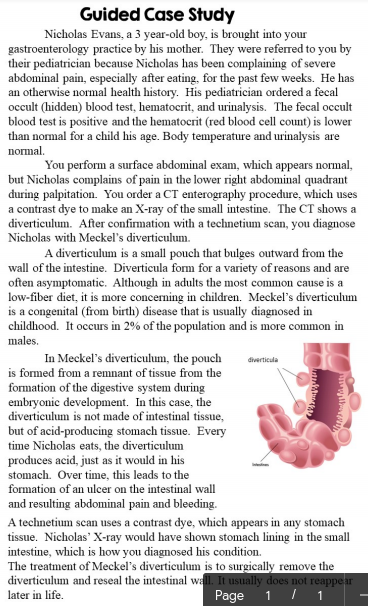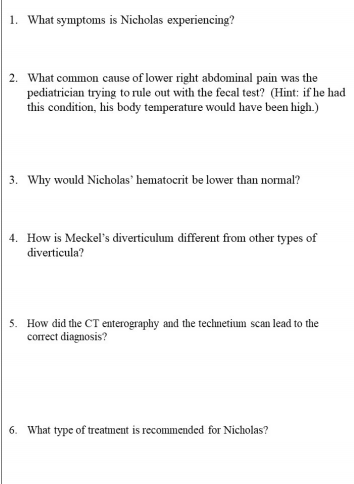Guided Case Study Nicholas Evans, a 3 year-old boy, is brought into your gastroenterology practice by his mother. They were referred to you by their pediatrician because Nicholas has been complaining of severe abdominal pain, especially after eating, for the past few weeks. He has an otherwise normal health history. His pediatrician ordered a fecal occult (hidden) blood test, hematocrit, and urinalysis. The fecal occult blood test is positive and the hematocrit (red blood cell count) is lower than normal for a child his age. Body temperature and urinalysis are normal. You perform a surface abdominal exam, which appears normal, but Nicholas complains of pain in the lower right abdominal quadrant đuring palpitation. You order a CT enterography procedure, which uses a contrast dye to make an X-ray of the small intestine. The CT shows a diverticulum. After confirmation with a technetium scan, you diagnose Nicholas with Meckel's diverticulum. A diverticulum is a small pouch that bulges outward from the wall of the intestine. Diverticula form for a variety of reasons and are often asymptomatic. Although in adults the most common cause is a low-fiber diet, it is more concening in children. Meckel's diverticulum is a congenital (from birth) disease that is usually diagnosed in childhood. It occurs in 2% of the population and is more common in males. In Meckel's diverticulum, the pouch diverticula is formed from a remnant of tissue from the formation of the digestive system during embryonic development. In this case, the diverticulum is not made of intestinal tissue, but of acid-producing stomach tissue. Every time Nicholas eats, the diverticulum produces acid, just as it would in his stomach. Over time, this leads to the formation of an ulcer on the intestinal wall and resulting abdominal pain and bleeding. A technetium scan uses a contrast dye, which appears in any stomach tissue. Nicholas' X-ray would have shown stomach lining in the small intestine, which is how you diagnosed his condition. The treatment of Meckel's diverticulum is to surgically remove the diverticulum and reseal the intestinal wall. It usually does not reappear Page 1 | 1 later in life.
Guided Case Study Nicholas Evans, a 3 year-old boy, is brought into your gastroenterology practice by his mother. They were referred to you by their pediatrician because Nicholas has been complaining of severe abdominal pain, especially after eating, for the past few weeks. He has an otherwise normal health history. His pediatrician ordered a fecal occult (hidden) blood test, hematocrit, and urinalysis. The fecal occult blood test is positive and the hematocrit (red blood cell count) is lower than normal for a child his age. Body temperature and urinalysis are normal. You perform a surface abdominal exam, which appears normal, but Nicholas complains of pain in the lower right abdominal quadrant đuring palpitation. You order a CT enterography procedure, which uses a contrast dye to make an X-ray of the small intestine. The CT shows a diverticulum. After confirmation with a technetium scan, you diagnose Nicholas with Meckel's diverticulum. A diverticulum is a small pouch that bulges outward from the wall of the intestine. Diverticula form for a variety of reasons and are often asymptomatic. Although in adults the most common cause is a low-fiber diet, it is more concening in children. Meckel's diverticulum is a congenital (from birth) disease that is usually diagnosed in childhood. It occurs in 2% of the population and is more common in males. In Meckel's diverticulum, the pouch diverticula is formed from a remnant of tissue from the formation of the digestive system during embryonic development. In this case, the diverticulum is not made of intestinal tissue, but of acid-producing stomach tissue. Every time Nicholas eats, the diverticulum produces acid, just as it would in his stomach. Over time, this leads to the formation of an ulcer on the intestinal wall and resulting abdominal pain and bleeding. A technetium scan uses a contrast dye, which appears in any stomach tissue. Nicholas' X-ray would have shown stomach lining in the small intestine, which is how you diagnosed his condition. The treatment of Meckel's diverticulum is to surgically remove the diverticulum and reseal the intestinal wall. It usually does not reappear Page 1 | 1 later in life.
Comprehensive Medical Assisting: Administrative and Clinical Competencies (MindTap Course List)
6th Edition
ISBN:9781305964792
Author:Wilburta Q. Lindh, Carol D. Tamparo, Barbara M. Dahl, Julie Morris, Cindy Correa
Publisher:Wilburta Q. Lindh, Carol D. Tamparo, Barbara M. Dahl, Julie Morris, Cindy Correa
Chapter31: Diagnostic Imaging
Section: Chapter Questions
Problem 31.3CS
Related questions
Question
Can Someone help me with the questions??

Transcribed Image Text:Guided Case Study
Nicholas Evans, a 3 year-old boy, is brought into your
gastroenterology practice by his mother. They were referred to you by
their pediatrician because Nicholas has been complaining of severe
abdominal pain, especially after eating, for the past few weeks. He has
an otherwise normal health history. His pediatrician ordered a fecal
occult (hidden) blood test, hematocrit, and urinalysis. The fecal occult
blood test is positive and the hematoerit (red blood cell count) is lower
than normal for a child his age. Body temperature and urinalysis are
normal.
You perform a surface abdominal exam, which appears normal,
but Nicholas complains of pain in the lower right abdominal quadrant
during palpitation. You order a CT enterography procedure, which uses
a contrast dye to make an X-ray of the small intestine. The CT shows a
diverticulum. After confirmation with a technetium scan, you diagnose
Nicholas with Meckel's diverticulum.
A diverticulum is a small pouch that bulges outward from the
wall of the intestine. Diverticula form for a variety of reasons and are
often asymptomatic. Although in adults the most common cause is a
low-fiber diet, it is more concerning in children. Meckel's diverticulum
is a congenital (from birth) disease that is usually diagnosed in
childhood. It occurs in 2% of the population and is more common in
males.
In Meckel's diverticulum, the pouch
is formed from a remnant of tissue from the
diverticula
formation of the digestive system during
embryonic development. In this case, the
diverticulum is not made of intestinal tissue,
but of acid-producing stomach tissue. Every
time Nicholas eats, the diverticulum
produces acid, just as it would in his
stomach. Over time, this leads to the
formation of an ulcer on the intestinal wall
and resulting abdominal pain and bleeding.
A technetium scan uses a contrast dye, which appears in any stomach
tissue. Nicholas' X-ray would have shown stomach lining in the small
intestine, which is how you diagnosed his condition.
The treatment of Meckel's diverticulum is to surgically remove the
diverticulum and reseal the intestinal wall. It usually does not reappear
Page 1 / 1
later in life.

Transcribed Image Text:1. What symptoms is Nicholas experiencing?
2. What common cause of lower right abdominal pain was the
pediatrician trying to rule out with the fecal test? (Hint: if he had
this condition, his body temperature would have been high.)
3. Why would Nicholas hematocrit be lower than normal?
4. How is Meckel's diverticulum different from other types of
diverticula?
5. How did the CT enterography and the technetium scan lead to the
correct diagnosis?
6. What type of treatment is recommended for Nicholas?
Expert Solution
This question has been solved!
Explore an expertly crafted, step-by-step solution for a thorough understanding of key concepts.
This is a popular solution!
Trending now
This is a popular solution!
Step by step
Solved in 2 steps

Follow-up Questions
Read through expert solutions to related follow-up questions below.
Follow-up Question

Transcribed Image Text:3. Why would Nicholas' hematocrit be lower than normal?
4. How is Meckel's diverticulum different from other types of
diverticula?
5. How did the CT enterography and the technetium scan lead to the
correct diagnosis?
6. What type of treatment is recommended for Nicholas?
Solution
Knowledge Booster
Learn more about
Need a deep-dive on the concept behind this application? Look no further. Learn more about this topic, biology and related others by exploring similar questions and additional content below.Recommended textbooks for you

Comprehensive Medical Assisting: Administrative a…
Nursing
ISBN:
9781305964792
Author:
Wilburta Q. Lindh, Carol D. Tamparo, Barbara M. Dahl, Julie Morris, Cindy Correa
Publisher:
Cengage Learning


Understanding Health Insurance: A Guide to Billin…
Health & Nutrition
ISBN:
9781337679480
Author:
GREEN
Publisher:
Cengage

Comprehensive Medical Assisting: Administrative a…
Nursing
ISBN:
9781305964792
Author:
Wilburta Q. Lindh, Carol D. Tamparo, Barbara M. Dahl, Julie Morris, Cindy Correa
Publisher:
Cengage Learning


Understanding Health Insurance: A Guide to Billin…
Health & Nutrition
ISBN:
9781337679480
Author:
GREEN
Publisher:
Cengage